Articles
- Page Path
- HOME > J Korean Acad Nurs > Volume 38(4); 2008 > Article
-
Original Article
- Impact of Psychological Factors on Marital Satisfaction and Divorce Proneness in Clinical Couples
- Seong Sook Kong
-
Journal of Korean Academy of Nursing 2008;38(4):550-560.
DOI: https://doi.org/10.4040/jkan.2008.38.4.550
Published online: August 31, 2008
Associate Professor, Department of Nursing, Soonchunhyang University, Cheonan, Korea.
- Address reprint requests to: Kong, Seong Sook. Department of Nursing, Soonchunhyang University, 336-1 Ssangyong-dong, Cheonan 330-090, Korea. Tel: 82-41-570-2488, Fax: 82-41-575-9347, kongsun@sch.ac.kr
Copyright © 2008 Korean Society of Nursing Science
Abstract
-
Purpose
- The purpose of the study was to investigate the psychological factors that affect marital satisfaction or divorce likelihood in clinical couples.
-
Methods
- Clinical couples (n=57) who visited "M" couple clinic participated in the study. Data was collected from September 2005 to June 2006 using a Marital Satisfaction Scale, a Marital Status Inventory, Beck Depression Inventory, Maudsley Obsessional-Compulsive Inventory, and Minnesota Multiphasic Personality Inventory.
-
Results
- The couples showed high scores on depression, obsessive-compulsion, personality factors and divorce probability and a low score on marital satisfaction. The wife's obsessive-compulsion was a predictor of her marital satisfaction, and the wife's social introversion and depression, and husband's obsessive-compulsion were predictors of the wife's prospect of divorce. The husband's hypomania and depression were predictors of his marital satisfaction, and there were no predictors of the husband's prospect of divorce.
-
Conclusion
- Obsessive-compulsion is a significant factor in a couple's relationship, although previous studies have not been interested in obsessive-compulsion. Divorce likelihood should be evaluated for clinical couples as well as marital satisfaction, because it is more important for divorce prevention. Each spouse who has a psychological problem such as depression, obsessive-compulsion, and deviated personality needs individual therapy as well as couple therapy.
- 1. Amato PR, Hohmann-Marriott B. A comparison of high- and low- distress marriages that end in divorce. Journal of Marriage and Family. 2007;69:621–638.Article
- 2. Arntz A, Voncken M, Goosen AC. Responsibility and obsessive-compulsive disorder: An experimental test. Behavior Research and Therapy. 2007;45:425–435.Article
- 3. Beck AT, Ward CH, Mendelson M, Mock J, Erbaugh J. An inventory for measuring depression. Archives of General Psychiatry. 1961;4:561–571.ArticlePubMed
- 4. Black DW, Gaffney G, Schlosser S, Gabel J. The impact of obsessive-compulsive disorder on the family: Preliminary findings. The Journal of Nervous and Mental Disease. 1998;186:440–442.ArticlePubMed
- 5. Borenstein M, Rothstein H, Cohen J. Power and precision. 1997;Mahwah, NJ, Lawrence Erlbaum.
- 6. Botwin MD, Buss DM, Shackelford TK. Personality and mate preferences: Five factors in mate selection and marital satisfaction. Journal of Personality. 1997;65:107–136.ArticlePubMed
- 7. Bray JH, Hetherington EM. Families in transition: Introduction and overview. Journal of Family Psychology. 1993;7:3–9.Article
- 8. Cho DK. The study of objective measurement for obsessional-compulsive behavior: The standardization of the list of obsessional-compulsive behavior in Maudsley obsessional-compulsive inventory. Seoul University Student Review. 1985;20:78–90.
- 9. Fals-Stewart W, Birchler GR, Schafer J, Lucente S. The personality of marital distress: An empirical typology. Journal of Personality Assessment. 1994;62:223–241.ArticlePubMed
- 10. Hathaway SR, McKinley JC. The Minnesota Multiphasic Personality Inventory. 1943;Rev. ed. Minneapolis, MN, University of Minnesota Press.
- 11. Heavey CL, Layne C, Christensen A. Gender and conflict structure in marital interaction: A replication and extension. Journal of Consulting and Clinical Psychology. 1993;61:16–27.ArticlePubMed
- 12. Hjemboe S, Butcher JN. Couples in marital distress: A study of personality factors as measured by the MMPI-2. Journal of Personality Assessment. 1991;57:216–237.ArticlePubMed
- 13. Hodgson RJ, Rachman S. Obsessional-compulsive complaints. Behaviour Research and Therapy. 1977;15:389–395.ArticlePubMed
- 14. Kim YH, Kim JH, Kim JS, Noh ML, Shin DK, Yeum TH, et al. The Guide for MMPI. 1994;Seoul, Korean Guidance.
- 15. Korea Marital Relationship Enhancement Institute. Clinical application of Gottman's marital therapy model. 2004;Seoul, Korea Marital Relationship Enhancement Institute.
- 16. Kwon JH, Chae GM. A validation study of the Korean Marital Satisfaction Iventory. Korean Journal of Clinical Psychology. 1999;18:123–139.
- 17. Lee IS, Yoo YJ. An assessment of the validity of the marital satisfaction scale. Korean Journal of Home Management Association. 1986;4:1–13.
- 18. Lee KS. Predictors of divorce intention, attempt, and plan. The Korean Journal of Woman Psychology. 2001;6:97–119.
- 19. Lee YH, Song JY. A study of the reliability and the validity of the BDI, SDS, and MMPI-D scales. Korean Journal of Clinical Psychology. 1991;10:98–113.
- 20. McCranie EW, Kahan J. Personality and multiple divorce. A prospective study. The Journal of Nervous and Mental Disease. 1986;174:161–164.ArticlePubMed
- 21. Ollendick DG, Otto BJ, Heider SM. Marital MMPI characteristics: A test of Arnold's signs. Journal of Clinical Psychology. 1983;39:240–245.ArticlePubMed
- 22. Park YH, Ko JH. The effects of self and spouse's self-esteem, communication, conflict coping behaviors on marital satisfaction. The Korean Journal of Social and Personality Psychology. 2005;19:65–83.
- 23. Previti D, Amato PR. Why stay married? rewards, barriers, and marital stability. Journal of Marriage and Family. 2003;65:561–573.Article
- 24. Rehman US, Gollan J, Mortimer AR. The marital context of depression: Research, limitations, and new directions. Clinical Psychology Review. 2008;28:179–198.ArticlePubMed
- 25. Roach A, Frazier L, Bowden S. The marital satisfaction scale: Development of a measure for intervention research. Journal of Marriage and Family. 1981;43:537–545.Article
- 26. Rogge RD, Bradbury TN, Hahlweg K, Engl J, Thurmaier F. Predicting marital distress and dissolution: Refining the two-factor hypothesis. Journal of Family Psychology. 2006;20:156–159.ArticlePubMed
- 27. Rotermann M. Marital breakdown and subsequent depression. Health Reports. 2007;18(2):33–44.
- 28. Stokes SB, Wampler RS. Remarried clients seeking marital therapy: Differences in levels of psychological and marital distress. Journal of Divorce & Remarriage. 2002;38:91–106.Article
- 29. Weiss RL, Cerreto MC. Development of a measure of dissolution potential. American Journal of Family Therapy. 1980;8:80–85.
- 30. Whisman MA, Uebelacker LA, Weinstock LM. Psychopathology and marital satisfaction: The importance of evaluating both partners. Journal of Consulting and Clinical Psychology. 2004;72:830–838.ArticlePubMed
REFERENCES
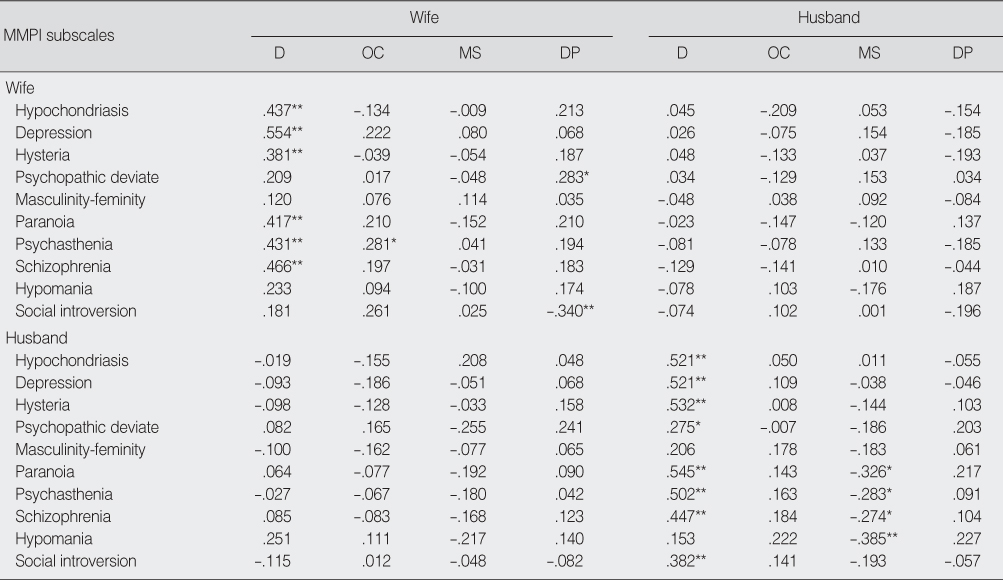
Figure & Data
REFERENCES
Citations

- Social support and symptom severity among patients with obsessive-compulsive disorder or panic disorder with agoraphobia: A systematic review
Véronique Palardy, Ghassan El-Baalbaki, Catherine Fredette, Elias Rizkallah, Stéphane Guay
Europe’s Journal of Psychology.2018; 14(1): 254. CrossRef - Success Factors for Marital Satisfaction of Women in South Korea: Focusing on Interaction Factors
Eun-Ju LEE, Euna PARK
JOURNAL OF FISHRIES AND MARINE SCIENCES EDUCATION.2018; 30(3): 1051. CrossRef - Variables Influencing Martial Satisfaction of Newly Married Men and Women
Eun-Joo Jeon, Deuk-Sung Kim
Journal of Korean Home Management Association.2013; 31(1): 73. CrossRef - Relationships between Myers-Briggs Type Indicator (MBTI) Psychological Type and Marital Satisfaction, Divorce Proneness, Positive Affect, and Conflict Regulation in Clinic Couples
Seong Sook Kong
Journal of Korean Academy of Nursing.2010; 40(3): 336. CrossRef
Demographic Characteristics of the Subjects (N=57)
Demographic Characteristics and Major Variables of the Couples (N=57)
Major Variables of the Couples according to Cutoff Scores (N=57)
*N=56 (one uncompleted questionnaire for wife's MOCI was excluded); **This frequency is calculated by counting the number of participants who corresponded to at least one subscale among 10 subscales of MMPI.
Correlations among Marital Satisfaction, Divorce Proneness, Depression, Obsessive-Compulsion and MMPI subscales in Couples
D=depression; OC=obsessive-compulsion; MS=marital satisfaction; DP=divorce proneness.
*p<.05; **p<.01; ***p<.001.
Correlations among Marital Satisfaction, Divorce Proneness, and Psychological Factors in Couples
D=depression; OC=obsessive-compulsion; MS=marital satisfaction; DP=divorce proneness.
*p<.05; **p<.01; ***p<.001.
†This is made with dummy variable (correspondents with ≤30 or 70≤ at least one subscale among 10 subscales of MMPI, 0; correspondents with 31-69 in all 10 subscales of MMPI, 1).
Stepwise Multiple Regression for Marital Satisfaction and Divorce Proneness
MA=hypomania; SI=social introversion.
*N=56 (one uncompleted questionnaire for wife's MOCI was excluded); **This frequency is calculated by counting the number of participants who corresponded to at least one subscale among 10 subscales of MMPI.
D=depression; OC=obsessive-compulsion; MS=marital satisfaction; DP=divorce proneness. *p<.05; **p<.01; ***p<.001.
D=depression; OC=obsessive-compulsion; MS=marital satisfaction; DP=divorce proneness. *p<.05; **p<.01; ***p<.001. †This is made with dummy variable (correspondents with ≤30 or 70≤ at least one subscale among 10 subscales of MMPI, 0; correspondents with 31-69 in all 10 subscales of MMPI, 1).
MA=hypomania; SI=social introversion.
 KSNS
KSNS
 E-SUBMISSION
E-SUBMISSION
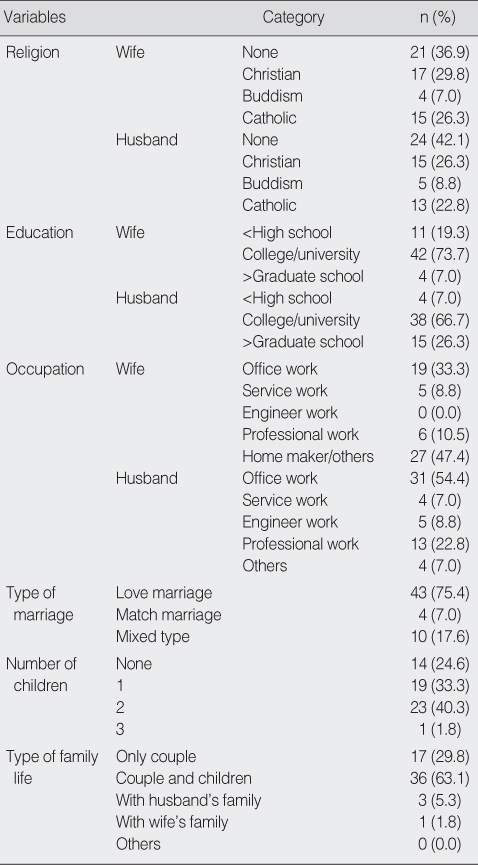
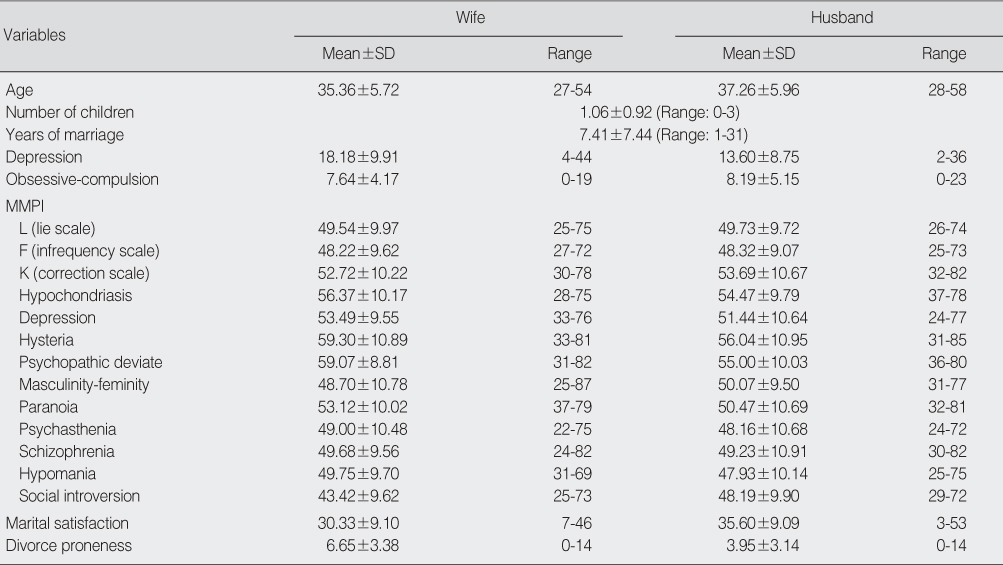
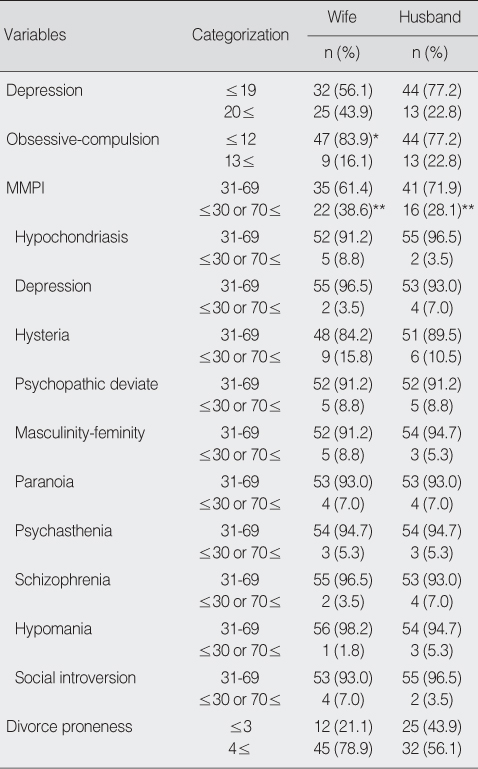
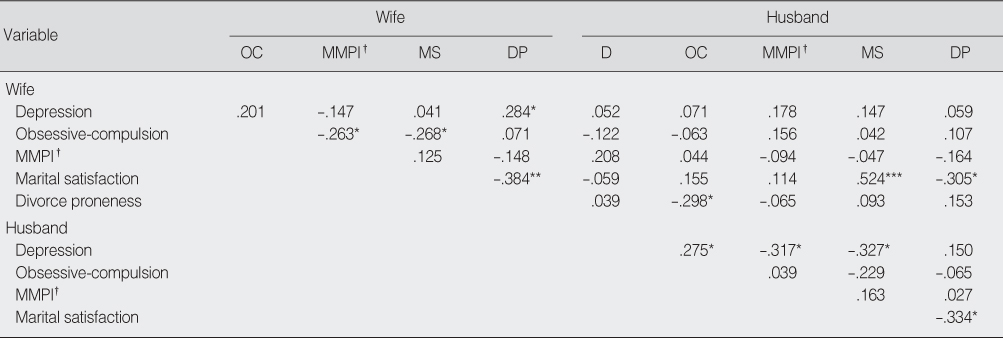

 Cite
Cite

